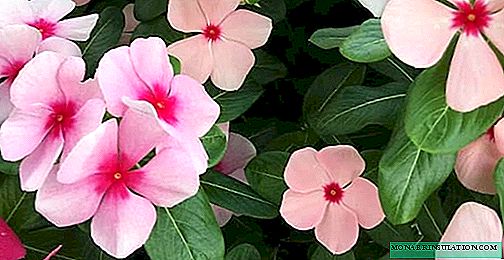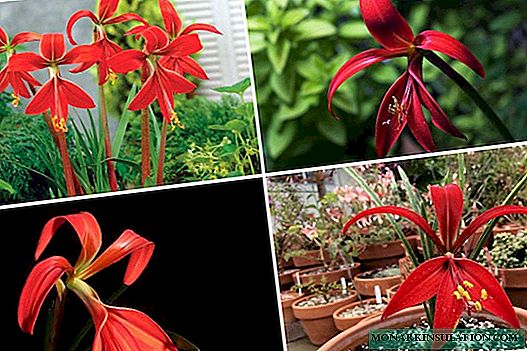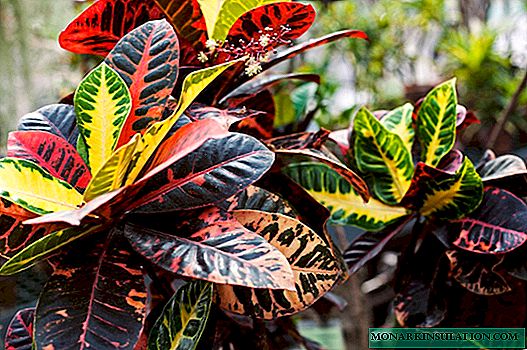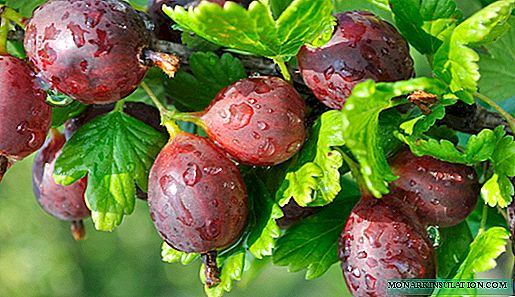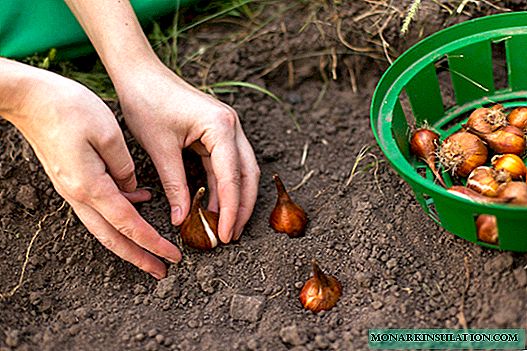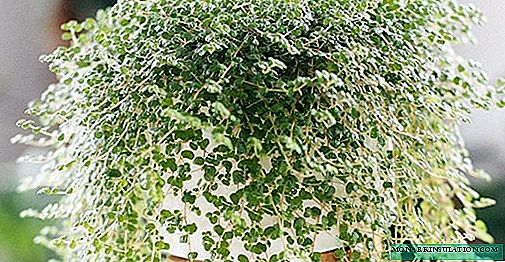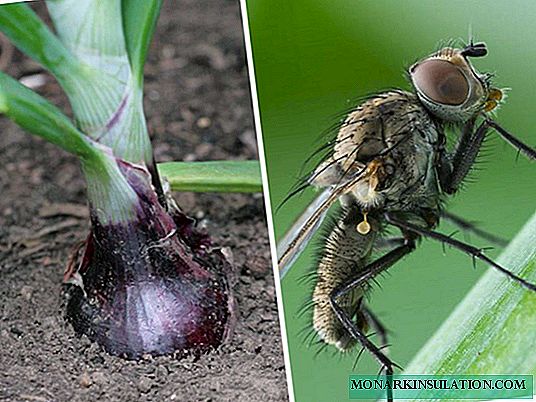
Onion is a rather unpretentious crop and, in comparison, for example, with tomatoes, cucumbers or eggplant, does not require any special care. However, it must be remembered that pests do not bypass onion beds. One of the most common and dangerous harmful insects is the onion fly, which can cause many problems to the gardener and destroy a significant part of the crop.
Pest Description
Despite its name, onion flies, in addition to various types of onions (onions, leeks, chives), also damage garlic, some types of lettuce and onion flowers (especially tulips). The pest affects crops not only in open ground, but also in greenhouses.
Appearance and Life Cycle
An onion fly is an inconspicuous small (about 7 mm) insect of an ashen-gray or yellow-gray color. The pest belongs to the order of dipterans and has a great resemblance to the usual housefly. Wings are transparent, can be with two or three longitudinal veins or without them. At the edges of the wings there is a fringe of thin long hairs.

Onion fly - a small insect (7 mm) that looks very similar to a regular housefly
The female lays from 40 to 60 eggs during her life, and from 5 to 20 at a time. Their size is about 1 mm. The eggs are white in color, have an elongated oval shape. Embryonic development is promoted by high soil moisture (60-80%). After about a week, larvae up to 10 mm in size appear, which immediately penetrate the bulb. They are legless, white. The body tapers toward the head, on which there are black mouth hooks. Larvae born from the same clutch stick together and eat out a single cavity inside the bulb.

A fly lays 5 to 20 eggs at a time, of which larvae hatch for a week and eat bulbs and feathers
After 15-20 days, the larvae leave the bulbs, crawl into the ground and pupate there, forming a false-cocoon. After 2-3 weeks, young flies of the next generation emerge from the pupae. This usually happens in July. In total, two generations of onion flies develop during the season; in the southern regions, under favorable conditions, a third generation may appear. The pest overwinters in the soil of those areas where the larvae developed, at a depth of 5-20 cm in the form of pseudocoons.

Onion fly hibernates in soil at a depth of 5-20 cm in the form of a chrysalis (pseudococcus)
What harm does an onion fly do?
The onion fly appearance period depends on climatic conditions and in different regions varies from late April to early June. The main reference point for the beginning of the mass outbreak of the pest is the moment of flowering of dandelions, lilacs and cherries.

As soon as the cherry blossoms, the gardener should be on the alert - the mass flight of the onion fly begins
Adult flies do not eat onions; they feed on the pollen of flowering plants. Their harm lies in the fact that females actively lay eggs in the soil during the season, on the protruding parts of the bulbs or between the leaves. Direct damage is caused by fly larvae. They hit onions of the first and second year of development. In seedlings, the larvae damage the feather. In onions of the second year of vegetation, they crawl through the bosom of the leaves inside the bulb or penetrate into it from the bottom, suck out the juice and eat out the flesh, as a result of which the bulbs rot and the plants die.
Reasons for defeat
The fight against the onion fly that has already appeared can be quite difficult and not always successful. To conduct timely and correct preventive measures, it is necessary to know the reasons for the mass invasion of the pest on the onion beds. Among them are:
- violation of crop rotation rules;
- improper placement of crops in the garden (poor choice of neighbors);
- late onion planting;
- lack of deep autumn digging of the soil;
- the use of infected and untreated seed before planting.
Signs of Onion Fly Damage
It is almost impossible to see the eggs and larvae of the pest due to its small size. In addition, their activity mainly takes place underground, so when external signs of damage to plants by an onion fly appear, the time to save the crop is often lost. Signs of onion damage by a pest are manifested both on the ground and underground parts of plants and are as follows:
- slowing the growth and development of onions;
- yellowing, wilting and drying of green feathers and arrows;
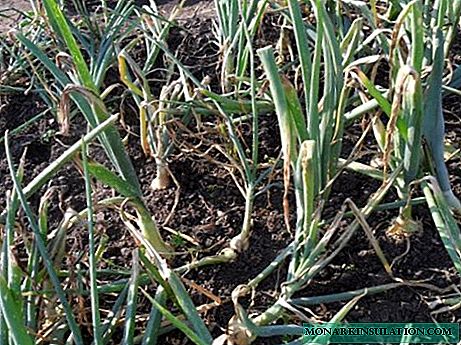
When affected by an onion fly, the ground parts of the plants turn yellow, wither and wither
- the appearance of an unpleasant putrefactive odor;
- softening and rotting of bulbs;
- the formation inside the bulbs of cavities with white worms (larvae);

Onion fly larvae eat out cavities inside the bulbs, causing them to rot
- accumulation of larvae on the roots of the bulb.

Onion fly larvae can be seen on the roots of the bulb
With the appearance of such signs of damage, it is already impossible to save the plants. Such products should not be eaten.
Pest Prevention
Preventing the spread of the pest is always preferable and safer for the crop. To prevent damage to plants by an onion fly, the following preventive measures can be taken:
- Compliance with crop rotation. Planting onions in the same place no earlier than 3-4 years.
- The correct selection of predecessors and neighbors for onions: carrots, tomatoes, cucumbers, cabbage.

Carrots are advised to be planted next to the onion, as its smell repels the onion fly.
- Deep autumn digging of beds intended for planting onions. It is produced with turning over of the strata (autumn plowing) for deeper freezing of the soil so that the false-cocoons that are in it die.
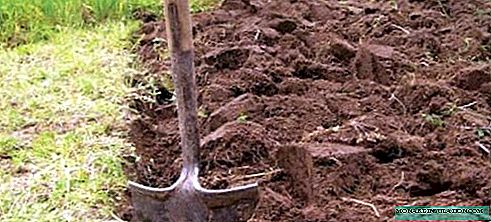
Deep autumn digging of the soil contributes to the death of onion fly larvae
- Pre-treatment of onion sets. It is made by soaking it before planting in one of the following ways:
- in hot water at a temperature of 45-46 ° C for 10-15 minutes, at 50-52 ° C - 3-5 minutes;
- in a solution of potassium permanganate (1 g / l) for 30 minutes;
- in an aqueous solution of birch tar (1 tablespoon per liter of settled water) for 2-3 hours.
- Early onion planting, so that he has time to grow stronger before the appearance of the pest.
- Repelling adult insects using strong odor products (both chemical and plant origin). Such tools will be discussed in more detail below.
- Minimum soil moisture during egg laying, as well as soil loosening after irrigation. A fly does not lay eggs on dry, loose earth.
- Timely collection and destruction of plant debris affected by the pest.
Video: birch tar as an onion fly prevention
Chemical treatment for onion flies
In advanced cases, when preventive measures were not taken in a timely manner, it is necessary to use chemical preparations. Their use is extremely undesirable, since onions have the ability to accumulate harmful substances and can be dangerous when eaten. During insecticide treatments, the dosage specified in the instructions must be observed, sprayed in the morning or evening in dry, calm weather, and also withstand the recommended waiting period. After processing with chemicals, it is better not to use onion feather at all.
Ammonia
Ammonia (aqueous ammonia) is a pungent odor liquid sold in pharmacies. It is a chemical drug, however, to a greater extent, the use of this tool to combat onion flies can be attributed to folk methods. There are no clear instructions for its use in the sources.

Ammonia with its pungent odor repels onion flies
Regarding the concentration of the solution, there are various recommendations: from one to five tablespoons per 10 liters of water. It is believed that for the use of the drug for prevention, it is enough to dilute 1-2 tablespoons of the drug, it is recommended to increase the concentration in case of a significant number of plants. Ten liters of solution will be enough to spill 2 m2 landings. They begin to process onions during the flowering period of cherries, and then do it several more times with an interval of 7-10 days. The beds are pre-watered with clean water, then with a solution between the rows of onions and again with clean water.
Video: ammonia treatment against onion flies
Metronidazole
These are antibacterial tablets used to treat people who can be bought at the pharmacy. Their use as a means of combating onion flies, most likely, can also be attributed to folk remedies. Information on the concentration of the solution varies. The most common dosage is 4 tablets per 10 liters of water, but there are other options - from 5 to 10 tablets for the same amount of water. Metronidazole is used to combat fly larvae. Processing is carried out once, when the pen is already strong and will be at least 5 centimeters in height.

Some gardeners use metronidazole to control onion flies.
Reviews about the use of this tool are contradictory. Some gardeners claim the effectiveness of the drug against onion flies, while others have not received any result from the treatments.
I tried to search for information on watering onions with metronidazole from an onion fly on the Internet, but could not find it, so I will share how I did it myself. I was told that 10 tablets of metronidazole are used for 10 liters of water. True, everyone does it differently, some use 5 tablets per 10 liters of water for watering. I decided that I would use the middle option. She poured 5 tablets and poured the resulting powder into an 8-liter watering can. I mixed and poured the onion with the resulting solution. After 1.5 days, she plucked a feather, looked and saw live larvae of the onion fly in it. I don’t know, either little time has passed, or it was still necessary to use 10 tablets per 10 liters of water, I’ll see what will happen next.
natla//www.bolshoyvopros.ru/questions/1584569-kak-razvodit-metronidazol-dlja-poliva-luka-ot-lukovoj-muhi-kak-polivat.html
Metronidazole is an ambiguous tool not only regarding the concentration of the solution and its effectiveness in the fight against onion flies. Diluting ten tablets per bucket of water or even one tablet can be hazardous to health.
Zemlin
The popular zemlin garden insecticide is used during onion planting. The toxic activity of the drug lasts up to 60 days. From an onion fly, the remedy can be introduced symptomatically into the upper layers of the soil when it is urgently needed. For humans, Zemlin is not toxic. Available in the form of granular powder, which is scattered on the soil, followed by loosening. The consumption rate is 3 g / m2. For a more even distribution, the drug is used in a mixture with sand. A half-liter capacity is filled with sand by 3/4, 30 g of granules are added thereto and mixed. In case of massive pest damage, the drug is used for 2-4 consecutive seasons until they disappear completely.

Zemlin is scattered on the beds during the planting of onions, its effect lasts up to 60 days
Fly-eater
The drug has been successfully used to combat insects and larvae of onion flies. The fly-eater is considered harmless to the soil and beneficial organisms. Thanks to the aromatic bait, the pest eats it and dies within two to three days. After moisturizing (precipitation or watering), the active substance penetrates the plants and acts poisonously on flying insects. Therefore, the fly-eater is not used for processing plantings of onions on a feather or introduced into the soil in advance in order to withstand the waiting period before eating onion leaves. The drug is produced in the form of granules, used once before planting onions. Its effect lasts for two months, this period is also a waiting period. Granules are scattered at the rate of 5 g / m2 at an air temperature of no higher than 25 ° C and produce surface loosening of the soil.

The fly-eater is effective against onion flies and is harmless to soil and beneficial organisms.
Inta Vir
The popular and inexpensive insecticide Inta-Vir has moderate toxicity and is successfully used by gardeners to combat onion flies. The solution is prepared at the rate of one tablet per 10 liters of water, it is used immediately after preparation. It is possible to process the beds from an ordinary watering can or using a spray gun. Reprocessing is allowed no earlier than 14 days. The same amount of time you can not eat vegetables after using the drug. You can do no more than three treatments per season.

Inta-Vir - a popular insecticide with moderate toxicity, successfully used to combat onion flies
Alatar
This tool destroys almost all pests of garden and horticultural crops, including onion flies. The inclusion of two active poisons in the composition of Alatar provides the drug with a combined mechanism of action on the body of the pest, resulting in high mortality of its large-scale colonies. Alatar can be used twice, withstanding an interval between treatments of 10 days. More than two times, the drug is used very rarely. The waiting period is 3 weeks. To prepare a working solution, 5 ml of the drug is diluted in 4 l of water, this amount is enough to process 100 m2. Alatar is not washed off by rain water, and is also resistant to ultraviolet rays and high air temperatures.

Alatar contains two active poisons, which ensures high efficacy of the drug against most pests.
Creolin
Reviews about the effectiveness of this drug in the fight against onion fly are positive, even enthusiastic. However, Creolin is recommended to be used as a last resort, when other methods do not give the desired result, since the remedy is very toxic. The drug is a viscous liquid with a pronounced pungent odor, consists of naphthalene, coal oil, ichthyol. It is used by veterinarians as an antiparasitic agent.

Creolin is very toxic, so it is used with great care.
The instructions for creolin, which is sold in pharmacies, contain compositions for treating animals and premises from ticks and other parasites. Creole is not on the list of approved drugs, but it is part of many pesticides. The most common dosage option in sources is 2 tablespoons per 10 liters of water. The first treatment can be carried out when the feathers of the bow reach a length of 8-10 cm, the second - after three weeks.
Folk ways of struggle
The vast majority of folk methods of dealing with onion flies have a deterrent effect and do not completely destroy pests. Their application begins before the insects fly and, as a rule, the treatment is carried out 2-3 times per season.
Potassium permanganate
Potassium permanganate (potassium permanganate or potassium permanganate) is diluted in the proportion of 1 teaspoon per 10 liters of water, the solution should turn out to be pink-saturated. Watering the beds immediately after planting, and then the treatment is repeated after 10 days and again after 7-10 days. It is believed that the tool prevents the appearance of the onion fly and its larvae, however, there is an opinion about the effectiveness of potassium permanganate only in the fight against diseases, and not with pests.

Many gardeners use potassium permanganate to fight onion flies
Salt
A rather controversial method of dealing with onion flies is saline treatment. Its effectiveness against larvae is not in doubt. However, there is a wide variety of recommended dosages for the preparation of the solution, and there is also no consensus on the multiplicity of treatments.
As for the amount of salt that needs to be diluted in 10 liters of water, then in the sources you can find recommendations from 100 to 600 grams. Often referred to as a three-time treatment technique, which involves increasing the concentration of saline solution with each subsequent spraying. The first treatment is carried out at the rate of 200-300 g of salt per bucket of water when the feather reaches 5 cm in height. After 15-20 days, watered repeatedly with a more saturated solution (350-450 g per 10 liters). The third time is treated in three weeks, while 500-600 g of salt is taken for the same volume of water. During spraying, the solution is avoided on the feather of the onion, 3-4 hours after each treatment the beds are spilled with clean water.
When describing this method of dealing with onion flies, it is noted that its use leads to a deterioration in soil quality due to its excessive salinization. It is believed that such processing can be applied no more than once a year.

Salt effectively destroys onion fly larvae, but at the same time it accumulates in the soil and worsens its quality
Kerosene
A fairly effective way against an onion fly is to treat it with a solution of kerosene, the specific smell of which will repel the pest. The concentration of the solution is 2-3 tablespoons per 10 liters of water. The first treatment is carried out when the feather grows to 8-10 cm. Water the onions under the root, trying not to get on the plants. After a few hours, the onions are abundantly watered with clean water. The treatment is repeated twice more with an interval of 10-14 days. It is argued that this method of struggle is not harmful to human health. You can also use a combined kerosene-salt solution by stirring in a bucket of water 2 tablespoons of kerosene and 1 cup of salt.
Vinegar
Vinegar is also used to combat onion flies. It can be applied in two ways:
- In small containers dilute vinegar essence with water (1 tablespoon of essence for 3-4 tablespoons of water) and place them in the rows of onion beds. When the liquid evaporates, especially under the influence of sunlight, a specific odor that repels the pest will spread.
- Spray onion beds with a solution of vinegar at the rate of 1 tablespoon of essence per 10 liters of water.

Vinegar (vinegar essence) is used not only in cooking, it is considered a fairly effective remedy for onion flies
Ash
Onion fly and its larvae die after processing the beds with ash. It is scattered on the beds and carry out surface loosening of the soil.
To obtain environmentally friendly wood ash, it is necessary to burn natural waste: dry branches, deadwood weeds, last year's leaves and so on. It is not recommended to use the ash obtained as a result of burning construction waste.
A more effective mixture will be one glass of wood ash with tobacco dust and ground pepper, taken one teaspoon each. Processing begins in early May and is repeated 3-4 times with an interval of 7 days. And you can also water the onion 2 times a week with ash infusion (2 cups per 10 liters of water) with the addition of laundry soap so that the solution stays on the plants longer.
Video: using fly ash to control onion fly
Tobacco dust
An economical and environmentally friendly way to deal with onion flies. Two hundred grams of tobacco dust is poured with 10 liters of hot water and insisted for several days. Grated laundry or liquid soap is added to the infusion and the onions are sprayed once a week. And also tobacco dust can be used in dry form, sprinkling it on the beds at the rate of 1 tablespoon per 1m2. In the same way, you can use a mixture of tobacco dust with lime (1: 1).

To combat the onion fly, dry tobacco dust is used, as well as in the form of infusion
Other folk ways
There are a number of folk remedies to combat the onion fly. The most popular of them are the following:
- Herbal infusions from plants with a pungent odor (wormwood, tansy, valerian, ledum, needles, mint) are used to scare the onion flies. Their use is absolutely safe, so you can carry out frequent regular spraying with such infusions.
- The crushed dandelion roots (200 g) are poured with water (10 l) and insisted for 7 days. Onions are sprayed once every two weeks until the insects awaken.
- An aqueous tar solution (1 tablespoon per 10 liters of water) is watered during the planting beds and 3-4 more times.
- To destroy the larvae, a mixture of soda with salt (1: 2) is used, which is poured under the bulbs.
- A mixture of naphthalene with sand or ash (1:10) is scattered 1-2 times in the affected areas during the flight of the onion fly and egg laying.
And the last advice from practical experience, maybe it will be useful to someone.
We have onion fly also causes a lot of problems. And next to the carrot bed I planted onions, and on one bed rows of onions / carrots alternated - to no avail! I wonder who this advice helps. But last year I mulched my onions with nettles, in our area it was overgrown - all the onions were clean!
Sima//otvet.mail.ru/question/178423385
Onion fly is certainly a dangerous pest. But you can cope with it if you correctly apply the appropriate measures of control and protection. The most difficult moment is the right choice of method. There is no doubt that preference should be given to the most harmless methods. It is not necessary to use chemicals without extreme necessity, since the goal of each gardener is not just to destroy the pest, but to grow high-quality environmentally friendly products.






